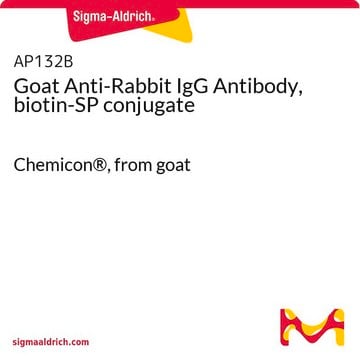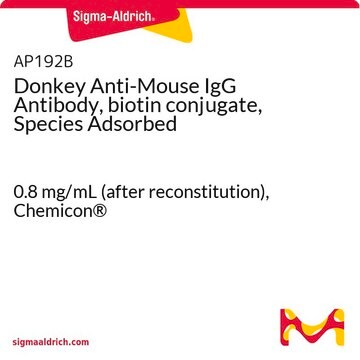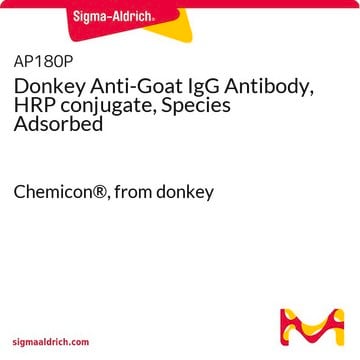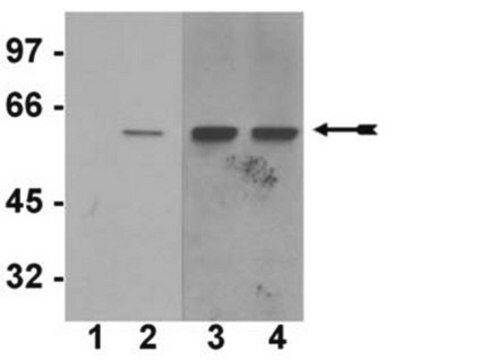おすすめの製品
特異性
Mouse IgG (H+L) (absorbed for minimal cross-reactivity to Rat, Human, Bovine and Horse Serum Proteins)
アプリケーション
Research Category
二次抗体及びコントロール抗体
二次抗体及びコントロール抗体
Research Sub Category
二重標識用 吸収処理済み二次抗体
二重標識用 吸収処理済み二次抗体
Detect Mouse IgG using this Goat anti-Mouse IgG Antibody, biotin-SP conjugate, Species Adsorbed validated for use in ELISA & WB.
Suggested dilution for most applications:
1:50,000-1:1000,000 for ELISA
1:10,000-1:1000,000 for Western blots
1:500-1:5000 for immunohistochemistry
1:200-1:1000 for FACS
1:50,000-1:1000,000 for ELISA
1:10,000-1:1000,000 for Western blots
1:500-1:5000 for immunohistochemistry
1:200-1:1000 for FACS
物理的形状
Lyophilized. Buffer = 0.01 M Sodium Phosphate, 0.25 M NaCl, pH 7.6, with 0.05% Sodium Azide.
RECONSTITUTION:
Reconstitute with sterile distilled water.
RECONSTITUTION:
Reconstitute with sterile distilled water.
保管および安定性
Maintain lyophilized product at 2-8°C for up to 12 months. After reconstitution the product is stable for several weeks at 2-8°C as an undiluted liquid. For extended storage after reconstitution, add an equal volume of glycerol to make a final concentration of 50% glycerol followed by storage at -20°C in undiluted aliquots for up to 12 months. Please note the concentration of protein (and buffer salts) will decrease to one-half of the original after the addition of glycerol. Avoid repeated freeze/thaw cycles.
法的情報
CHEMICON is a registered trademark of Merck KGaA, Darmstadt, Germany
免責事項
Unless otherwise stated in our catalog or other company documentation accompanying the product(s), our products are intended for research use only and are not to be used for any other purpose, which includes but is not limited to, unauthorized commercial uses, in vitro diagnostic uses, ex vivo or in vivo therapeutic uses or any type of consumption or application to humans or animals.
Not finding the right product?
Try our 製品選択ツール.
適用法令
試験研究用途を考慮した関連法令を主に挙げております。化学物質以外については、一部の情報のみ提供しています。 製品を安全かつ合法的に使用することは、使用者の義務です。最新情報により修正される場合があります。WEBの反映には時間を要することがあるため、適宜SDSをご参照ください。
毒物及び劇物取締法
毒物
Jan Code
AP181B:
試験成績書(COA)
製品のロット番号・バッチ番号を入力して、試験成績書(COA) を検索できます。ロット番号・バッチ番号は、製品ラベルに「Lot」または「Batch」に続いて記載されています。
Natsuko Tanabe et al.
Cells, 12(10) (2023-07-06)
Advanced glycation end-products (AGEs) are increased under hyperglycemia in vivo and are associated with the onset of diabetes. According to previous studies, AGEs exacerbate inflammatory diseases. However, the mechanism by which AGEs aggravate osteoblast inflammation remains unknown. Therefore, the aim
Kieran Dee et al.
The Journal of infectious diseases, 227(12), 1396-1406 (2022-12-23)
Multiple viruses cocirculate and contribute to the burden of respiratory disease. Virus-virus interactions can decrease susceptibility to infection and this interference can have an epidemiological impact. As humans are normally exposed to a community of cocirculating respiratory viruses, experimental coinfection
Natalia R Salvetti et al.
Biology of reproduction, 87(1), 22-22 (2012-04-28)
Prenatal testosterone (T) excess leads to reproductive dysfunctions in sheep, which include increased ovarian follicular recruitment and persistence. To test the hypothesis that follicular disruptions in T sheep stem from changes in the developmental ontogeny of ovarian proliferation and apoptotic
Laura M Molina et al.
Cell reports, 36(1), 109310-109310 (2021-07-08)
Yes-associated protein 1 (YAP1) regulates cell plasticity during liver injury, regeneration, and cancer, but its role in liver development is unknown. We detect YAP1 activity in biliary cells and in cells at the hepatobiliary bifurcation in single-cell RNA sequencing analysis
Jacquelyn O Russell et al.
The American journal of pathology, 188(6), 1389-1405 (2018-03-17)
Bromodomain and extraterminal (BET) proteins recruit key components of basic transcriptional machinery to promote gene expression. Aberrant expression and mutations in BET genes have been identified in many malignancies. Small molecule inhibitors of BET proteins such as JQ1 have shown
ライフサイエンス、有機合成、材料科学、クロマトグラフィー、分析など、あらゆる分野の研究に経験のあるメンバーがおります。.
製品に関するお問い合わせはこちら(テクニカルサービス)








